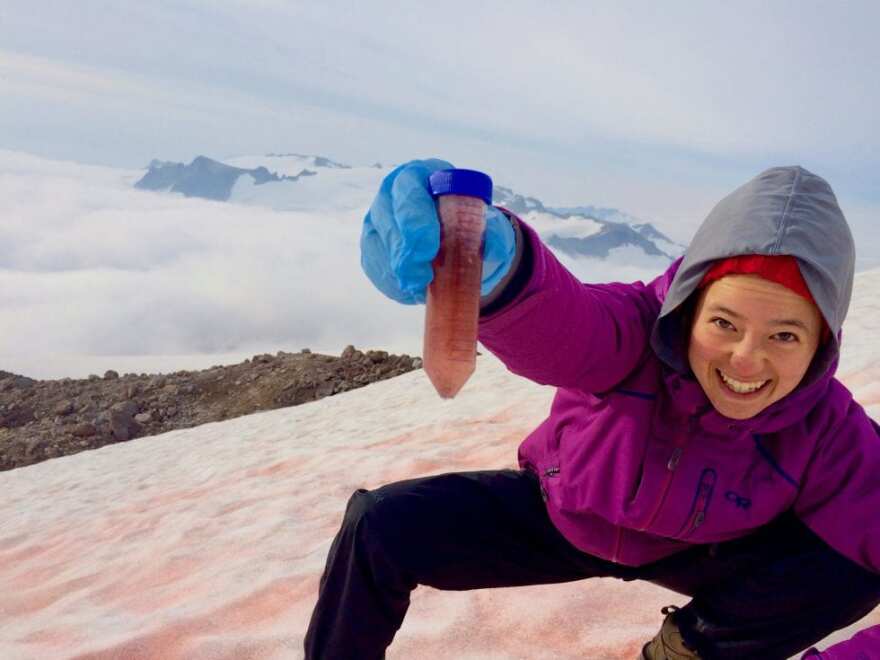As summer quickly approaches, snow is melting on the mountaintops. This time of year, some of that snow won’t be the pristine white color you think of. It turns out that in the spring and summer, snow often turns pink or even red thanks to microalgae that have been adapted to live in it, partly as a response to climate change.
Dr. Alison Murray is a research professor of biology at the Desert Research Institute. She is working with the Living Snow Project, which is comparing DNA from these pink snow samples to learn more about biodiversity and its impact on snowmelt. KUNR Morning Edition host Noah Glick sat down with Murray to learn more.
Noah Glick: First, tell me more about this pink snow. What is it? What do we know about it? Is it safe?
Dr. Alison Murray: Pink snow occurs in the spring to summer snowpack as the snow gets more liquid water in it. The pink color comes from what are green algae, but they have photoprotective pigments that are pink, red or orange. And that helps them as they get higher in the snowpack, protect them from the UV radiation from the sun.
Glick: Is this similar to the algae you’d see on Lake Tahoe, for example, but it’s just in the snow? When I hear about algae accumulating on Lake Tahoe or another body of water, it seems like, “Oh, that’s a bad thing, that there’s something going on with the health of the lake.” Is it the same thing in this case with the snowpack?
Murray: Often when we think of that in lakes, where there's really an overabundance of algae and algae blooms, that has to do a lot with nutrients that are running off from the land, from pollution and then we get these large blooms. In the snowpack, not necessarily. This snow algae, we find up in the Arctic and down in the Antarctic where there [is] very little human impact.
However, there is kind of an interesting link between what happens with algae when it’s in melting snowpack. There’s been some really outstanding studies that have happened in Greenland in the last couple of years, where there is a positive feedback loop with algae and climate change. And so the more algae that is in glacial ice or in snowpack, the faster the rates of melting that ice or snow. And so, if we have more algae, then we’ll have more rapid melting. The algae actually absorb heat in the ice or in the snow then, which creates that positive feedback loop.
Glick: So then let's talk about the project. What is it that you're trying to figure out? How are you going about it?
Murray: Yeah, so [the] Living Snow Project was started by a group led by Robin Kodner up at Western Washington University a couple of years ago, where they entrained the help of the community as citizen scientists to help collect samples in the Cascade Mountain range. And by using the power of multiple people, we can collect a lot more samples than one person going and collecting samples hiking all over.
So this year, Desert Research Institute has joined the Living Snow Project as a partner in engaging the community in Reno, Truckee [and] Tahoe to start collecting samples around the Sierra Nevada, with the same idea that if we can engage the citizen scientists — backcountry skiers and hikers — to help collect samples for us and observe the snow. So, there’s two different ways you can participate. And, we can start making much broader, bigger observations of where the snow algae is occurring. It's really patchy. So, you have to kind of look for it. It’s not everywhere.
Glick: So, is the goal then to try to map where this is happening? I’m just trying to envision here. You and your team, you get these samples. Then what?
Murray: The big question that we’re asking is not only where is it, but what is the diversity of that algae? What does the population structure look like? We don’t quite understand how it’s dispersed and how different the populations down here in the Sierra would be from the Cascades. And so, this project will provide a kind of first-order data that we can use to compare and look at the population structure and really look at how abundant it is.
Dr. Allison Murray is a research professor of biology at the Desert Research Institute. For more information on the Living Snow Project or to get involved, head to livingsnowproject.com.





